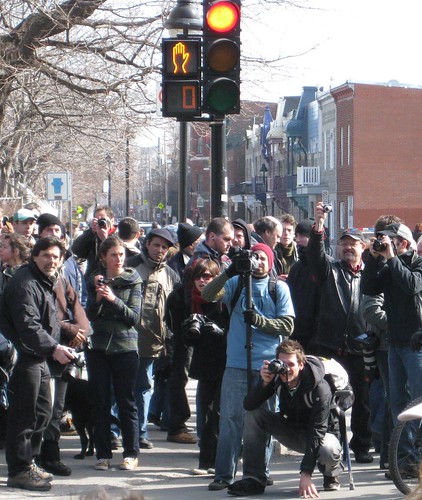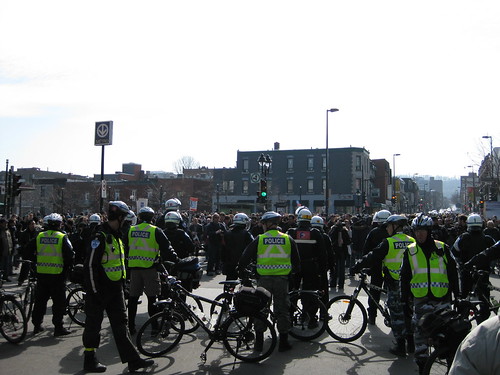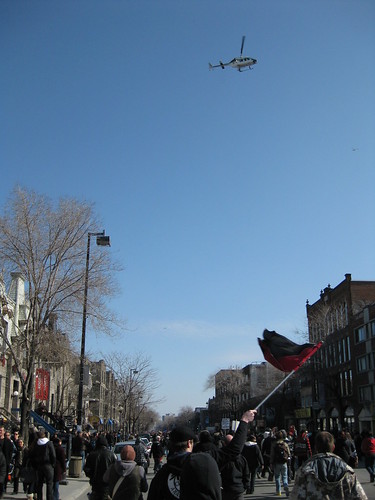
Police making their way up de Pins. This photo courtesy of Benoit Falardeau
By now anyone paying attention to the news knows that there was a demonstration against police brutality Sunday in Montreal. 221 people arrested, $200,000 in damages, and plenty of media hype.
Sunday marked the 13th International Day against Police Brutality. Le Collectif Opposé à la Brutalité Policiere (COBP) has organised the annual protest in Montreal since 1997. This year’s edition carried a particular significance: it was the first to follow the incendiary killing of unarmed Fredy Villanueva by Montreal police.
I made my way down to Mont Royal metro yesterday, not knowing exactly why. I’d heard various accounts of previous demonstrations against police brutality, but never one that started with “and then I saw…”
A moment of confrontation between protesters and police at St. Denis and Mont Royal. Sorry for the shaky camerawork.
I decided to attend as a resident who finds the structural brutality of racial and economic profiling unacceptable (let alone its resultant physical violence), but also as one who believes in the necessity of a regulated police department.
Beforehand I discussed with a friend the roles of police presence, the COBP, and the protest. Undoubtedly there is a certain element of brutality in the mere presence of helmeted, shielded, and armed police. They appear larger than human, especially when mounted on horseback. A violent uprising at such a high-tension event may be sparked simply by their aggressively-attired posturing. This left me with the question: what if the police stood up their annual date with the protesters and made a no-show? Would violence ensue?
The first thing I noticed upon arrival was the astounding amount of technology: my puny digital camera was no match for the hefty Canons clutched by salivating journalists. Crouching in various awkward poses, they appeared to be shooting a punk-rock fashion show. Activists and police carried cameras too. At least today, no brutality would go unrecorded.

Mounted police surveyed the mixed crowd of activists, families, and a few masked protesters. All ages were represented. The Anarchist Marching Band was delightfully in full swing, and the open sugar-shack added to the air of general spring euphoria.
As I climbed upon a concrete pillar behind the police, one of their ranks approached to ask me to not stand behind them, SVP. I noted that I could see his face through the clear visor, perhaps a small touch of crowd-control diplomacy?
The speeches and pamphlets delivered by the COBP were dedicated to Fredy Villenueva. The pamphlet impressively cataloged police intolerance and abuses. It offered insight into resisting police brutality, such as the SPVM’s recent switch to diminutive vehicle numbering which makes it harder to report errant officers.
At 2:30pm, the march began. As it made its way to St. Denis, a couple dozen of the group immediately engaged a line of bicycle police. Airborne vegetables and glass bottles scattered the line, and shield-wielding riot police took their place. Someone brandished a roman-candle firework, adding to the clamour. It was clear that any police entity, shielded or not, was the target of paint balloons and less-forgiving debris. I saw that one aggressive protester was pepper sprayed, another arrested.

Meanwhile, the rest of the march proceeded southbound on St. Denis. The atmosphere maintained its spring-time feel, with the band playing and onlookers enjoying the sight. The police, as if in answer to my question, were distant if visible at all (notwithstanding the helicopter presence). Minimal mischief occurred, with the odd paint balloon lobbed at a corporate store.
The Anarchist Marching Band
The feel changed as we approached Sherbrooke. There was a sense that a number of protesters, generally younger ones, were restless for a confrontation. One lone officer appeared in Square St. Louis, and a few rock-throwers ran after him. Another group of officers appeared near the Sherbrooke metro entrance, and a group of marchers surged at them. Dozens of young protesters frantically gathered rocks from construction sites and flower beds.
Two tear-gas explosions rocked the air, and it was clear that the police did not want the march to cross Sherbrooke. A couple hundred marchers detoured down a side street and re-entered Sherbrooke, headed westbound. An STM bus flashing “9-1-1 / Police” carried wide-eyed commuters through the surprise mob, it had become the target of paint balloons and angry fists. The manager of Dormez-vous? stepped outside to protect his storefront, and retreated when a brick sailed past him through the window.
I departed once the police fired rubber bullets into the crowd, dispersing it up University. On my walk home, I crossed a couple of
home-bound protesters who had dropped their sign in the street. They didn’t like that some marchers had targeted people other than the police.

My favourite part of the day had been on St. Denis, where a group of hundreds had energetically walked against the aggression that killed Fredy Villenueva. There the cops were scarce and the protesters lively. Beyond that, it seemed to be a chaotic yet well-rehearsed re-entrenchment of two parties: job security for the police, and the perpetual frustration of a few angry youth.

15 comments
Some ideas for the organizers:
Next year they should ask the angry kids with dangerous objects to leave the march before they start walking. If they are going to release their weird puberty needs, they should do it away from the demonstration, otherwise nobody is going to take the protest seriously and believe me, almost nobody does.
They should tell the police the route they are going to follow. That way the police will block the traffic as in any other protest. They have already been so destructive that they have all the means to force any route they want.
Seriously, we are looking like idiots all around the world because of these things. It’s time to stop it. Someone suggested making a march against hooligans. I would peacefully join that one, as I joined this one. That would be a first in the world!
The general feeling about this “annual chaos” is more and more of frustration against the marchers in Montreal.
Every year it is the same thing. Every year it turns into violence and damage.
This year, I could notice as well the high number of people with cameras, and curious people who just seems to hang around, making it harder to identify the actual trouble makers.
I am very concerned with what happened to Freddy Villanueva, and supported any means to denounce the judiciary protection that the policemen involved seems to have. But the poor images of destruction of property, unlucky people cars that were just in the way, facades of “Dormez-Vous”, UQAM or Ben Pizza place just gives less credibility to a serious debate we’re still waiting to have.
I just hope that next year, curious people won’t show up, and fail to feed the media frenzy operations, giving oportunity to a full range police action against the stupid kids who show up to destroy.
I never was in favour of police actions, and always felt like their presence created the trouble (souvenirs of Saint-Jean Baptiste at Mont-Royal park) but for this annual Montreal’s shame event, I wish the police could arrest all of them, and charge them with the full extent of their pointless destructions.
Do you have anything else to do on a beatifull Sunday afternoon?
I find it amusing to have such a march here in Montreal, where our police force has a huge emphasis on keeping the peace, rather than punishing wrongdoers. I live in the Latin Quarter, which can be a pretty rough neighbourhood at times, and I’ve been very impressed indeed to witness the police dealing with angry young men behaving badly — I’ve seen them calm things down and ignore insults hurled at them and let the ne’er-do-well grumble and go elsewhere instead of responding in kind and using force. Their attitude is one of “come on, we don’t want trouble, you don’t want trouble, so let’s resolve this peacefully, ok?” and not “damn young good-for-nothing hooligan, we’ll teach him a lesson.”
The police are not perfect, but really, I think a little perspective is needed.
I attended the very first annual demonstration against police brutality many years ago – 13? – this was in the wake of a series of police killings of unarmed young men of Black and other “visible” origins. It was utterly peaceful, just a normal picket, at least when I was there.
I also attended some of the neighbourhood demos for justice for Fredy Villanueva. But no way am I going to attend a demo when I know in advance that there are people (protestors or police) who are preparing to do battle.
Unfortunately I think the hooliganism discourages many people from the ethnic communities that face the brunt of police overreaction from attending (for many reasons, that could be discussed, from prejudice to misunderstanding) not only here but in many cities throughtout the “First World”.
I do love the idea of an Anarchist Marching Band…
I think these protesters should be sent to Beijing or Tehran to see what real police brutality looks like. Police brutality in Canada? Canada? Please.
From the images I have seen, I did not notice many ‘visible minorities’ present at this protest – on either side. If they were not there, that is unfortunate. It is also a sign that this protest is not really reaching out to the communities which most need help. The Montreal Police may be effective on a Friday night in the Latin Quarter when dealing with drunken Quebec Anarchists, but I have seen some very ugly and aggressive behaviour on their part in Snowdon.
In terms of ‘keeping the peace’ I think that the most important element is that the police force must truly be representative of the community that they serve, and understand where people are coming from.
Mr. Robertson, your idea that Canada is totally unstained by police brutality flies in the face of Fredy Villanueva’s death, and all of other incidents of police killing individuals (42 in Montreal since 1987, they say), when their job is to arrest criminals and bring them to justice (not to dispense their idea of it).
Yes, Canada’s government is not an oppressive totalitarian regime, but this was a protest against the violence of the police force. As far as I know police brutality isn’t government policy, that doesn’t mean it doesn’t happen. The police aren’t robots programmed to do only what the government tells them — they make mistakes, they get aggressive, they can get abusive, just like any individual. The police, too, are citizens who should be held accountable to their actions and brought to justice when they commit crimes.
That’s what this protest is about, and it turns to violence because it’s what the police want. If the police didn’t show up to arbitrarily decide when the protest (directed against them) is over, the destructive elements of the crowd who want to fight the police wouldn’t show up either. But as it stands, it’s cat-and-mouse, and both sides (which is to say, not all the protesters, but the destructive elements of it) are provocateurs.
Canada relies on a false image as a country of “nice” people who are free from discrimination and don’t do anything wrong in the world. There are worse places in the world, sure, yeah, but when the economy goes down nobody says, “Hey, you want to complain about the recession? Try living in Haiti.”
My point with the last sentence was that, with the economy, rather than point to a place that’s worse off than Canada and ignore it because everything is perfect here, we try to figure out how to improve the situation. Why don’t we do that with an issue like police brutality?
The hooligans are doing something really bad for the cause of the protest. Notice how most conversations in every blog and news source are about what they did and not about police brutality or even about the protest itself which consisted mostly of peaceful citizens. We need to stop talking and do something about it. We need to push the organizers of the march to release a statement about these hooligans. Maybe we need to organize a peaceful march against police brutality AND moronic destruction. Am I the only one who believes it is our duty to creatively restore our image around the world?
JF, of course there are isolated incidents of police brutality here as there are anywhere else. Despite this, 42 police killings in Montreal since 1987 is not doing too bad, and I’m sure that in most of those cases the individual they killed was armed and/or threatening them.
Villanueva’s death is unfortunate, but I believe it came out that him and a group of his friends were kicking a female police officer on the ground when another officer shot and killed him. We’re not talking about a model citizen here.
Although I do agree we can do better, I do not by any stretch of the imagination believe that Canadian police officers oppress the general public.
Unfortunately, hooligans have a long history of hijacking demonstrations in Montreal. I’ve been on more than one important march that turned sour because of skinny, white boys egging for a confrontation. If this march was truly against police brutality it would have taken place in Cote des neiges or Montreal north and would have been made up of people from those communities.
I passed by the metro station (Place Gerald-Godin, to be exact) at about 215 and the scene was wonderful and reminded me of Basque demonstrations I stumbled upon in Spain.
Between the cops with their red hats, the marchers with large signs, and the marching band, there was more than enough to see, hear, and smell. The chorus of tourists, flaneurs, and maple syrup lady just topped off the show. I imagine the choreography took much work, since it hit all the elements of a classical ballet or opera, with a Beckett/Kusturica twist to the absurd.
It’s really too bad the protest had to disrupt the human theatre.
I blogged about it here:
http://www.optative.net/blog/2009/03/16/police-brutalize-anti-police-brutality-demonstration-again
Donovan King points out that what I called the Anarchist Marching Band is actually the better named “Chaotic Insurrection Ensemble.” Great site:
http://chaoticinsurrectionensemble.org/about-ensemble-sur-l039ensemble
Why is there no march to protest the brutality of so-called anti-brutality protestors?